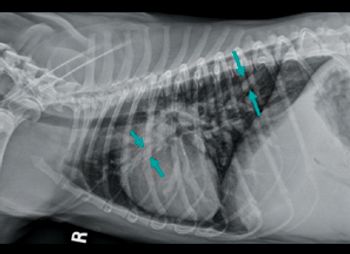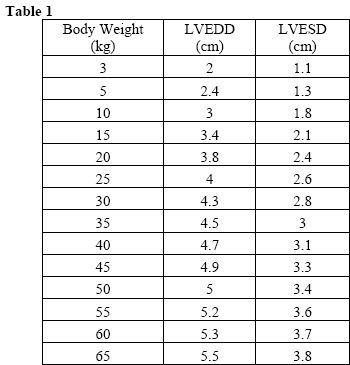
Dr. Jennifer Garcia helps ensure you're measuring blood pressure correctly in your patients.

Dr. Jennifer Garcia helps ensure you're measuring blood pressure correctly in your patients.

Understanding this syndrome's pathophysiology and classification schemes will help you better manage affected patients.

Once a death sentence, canine pulmonary hypertension no longer carries such a grave prognosis.

About 70 percent of dogs affected by mitral valve disease do not develop heart failure or die as a result.

Congenital heart disease (CHD) is a morphologic defect of the heart or great vessels which is present at birth. "Congenital" does not imply the defect was inherited, although many CHD are heritable. CHD may also be caused by de novo spontaneous mutations, which have the potential to be transmitted to progeny. Diagnosis of CHD is important for the health of the patient and also to eliminate affected individuals from the breeding pool.

The primary indication for obtaining an electrocardiogram (ECG) is to evaluate an arrhythmia. Patients with a history of syncope, episodic weakness, or collapse should be evaluated with an ECG. An ECG is an insensitive test for assessment of specific cardiac chamber enlargement, and interpretation of structural heart disease is best done using radiography and echocardiography.

Collapse and shock are a clinical manifestation of many different severe diseases, and requires emergency triage and care. Other dogs may present with a history of episodes of collapse and may be clinically stable on presentation. These two categories of patients are treated very differently, but they have some similar differential diagnoses.

Pericardial effusion is a fairly common acquired heart disease in dogs, and prevalence has been reported to be 0.43% (or 1 dog per 233 cases) of dogs presenting to a referral veterinary hospital, and accounts for approximately 7% of dogs with clinical signs of cardiac disease.1

Cats presenting with pleural effusion are nearly always in respiratory distress, ranging from an increased respiratory rate and effort to open mouth breathing. In the latter situations, therapeutic intervention must be initiated quickly to prevent respiratory arrest. The therapeutic intervention also provides your first diagnostic test.

Thrombophilia (hypercoagulability or prothrombotic state) is a complex disorder with a diverse and multifactorial pathogenesis that results in a wide spectrum of clinical manifestations. It is well-recognized as a frequent and serious cause of morbidity and mortality in people. It appears less prevalent in dogs and cats for several reasons.

A new study performed at Auburn University's College of Veterinary Medicine is radically changing our understanding of how heartworms affect the cat. In this study three groups of cats were studied for 8 and 16 months with antibody and antigen tests, radiographs of the heart and lungs, and necropsy examinations of the heart and lungs.

Pulmonary hypertension (PH) is defined by a systolic pulmonary artery pressure greater than 25 mmHg. The incidence of PH is difficult to define due to lack of clinical awareness, non-specific clinical signs, and difficulty in confirming the diagnosis.

Respiratory abnormalities are relatively common in cats, who may suffer from a wide range of disease processes. An initial triage step in the management of a dyspnic cat is to determine whether the dyspnea is cardiogenic or due to extracardiac (primary pulmonary) disease. This task is in no way a simple one, as cats often have non-specific history and physical examination abnormalities.

Tricks to handle the adverse effects: never with- hold water, always have water available or there will be much more significant dehydration and azotemia.

Echocardiography has emerged as the most valuable non-invasive tool for evaluation of cardiac structure, function, blood flow patterns, and has greatly diminished the need for diagnostic cardiac catheterizations and angiocardiography in many cases. Echocardiography is one tool for evaluation of the cardiac patient, but should be used in conjunction with other diagnostic tests including thoracic radiography and electrocardiography for a global assessment of the patient.

Although there are highly sophisticated and advanced diagnostic modalities in cardiology, the basic technique of a good cardiovascular examination is still an essential fundamental element of the cardiovascular workup. Other basic diagnostic modalities that are readily available in most practices include thoracic radiographs, electrocardiography, and blood pressure measurement.

This online on-demand archived Webinar will highlight the importance of differentiating between heart disease and heart failure and will discuss the impact on diagnosis, therapy and monitoring your feline patients. (1 CE credit)

This online on-demand archived Webinar will introduce you to a classification scheme for heart disease and heart failure and will discuss the clinical significance of signalment, history and common cardiac diagnostic tests to appropriately stage dogs and cats with heart disease. (1 CE credit)

What is the aim of this heart disease treatment?

One of the biggest risk factors for this condition in cats.

Technicians aren't all destined to be cardiologists. But all technicians should understand what a normal cardiac rhythm looks like and how it's generated.

New guidelines give veterinarians a tool for managing these cases in dogs.

Does the obesity paradox in people occur in cats as well?

Blood pressure measurement is often not a routine part of small animal practice. This partially has to do with the equipment available to measure blood pressure as well as our patients (they tend not to hold still like we have to).

Cardiovascular (CV) diseases in cats include congenital malformations, acquired heart, and vascular disorders. Myocardial disorders or cardiomyopathies, the major cause of heart failure, thromboembolism, and persistent arrhythmias in cats, constitute the focus of this presentation.